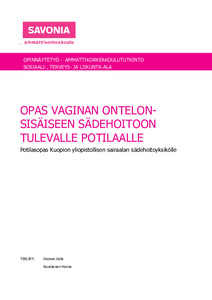Opas vaginan ontelonsisäiseen sädehoitoon tulevalle potilaalle
Ilvonen, Salla; Ruuskanen, Hanna (2021)
Ilvonen, Salla
Ruuskanen, Hanna
2021
Julkaisun pysyvä osoite on
https://urn.fi/URN:NBN:fi:amk-2021121626491
https://urn.fi/URN:NBN:fi:amk-2021121626491
Tiivistelmä
Vaginan ontelonsisäistä sädehoitoa voidaan käyttää yhtenä hoitomuotona synnytyselinten syövissä ulkoisen sädehoidon, leikkauksen ja solunsalpaajahoitojen kanssa. Kohtusyövän leikkauksen jälkeen annetaan usein vaginan ontelonsisäinen sädehoito estämään paikallinen uusiutuminen vaginan pohjaan. Tutkimukset ovat osoittaneet, että naiset tarvitsevat enemmän tietoa hoidosta, haittavaikutuksista ja hyvinvoinnin ylläpitämises-tä. Kehittämistyön tarkoituksena oli tuottaa Kuopion yliopistollisen sairaalan (KYS) sädehoitoyksikköön poti-lasopas vaginan ontelonsisäisestä sädehoidosta. Oppaan tavoitteena on antaa kirjallista tietoa vaginan ontelon-sisäiseen sädehoitoon tulevalle potilaalle ja omaisille. Kehittämistyön yleisenä tavoitteena on parantaa potilaan hoitokokemusta. Työn tilaaja oli KYSin sädehoitoyksikkö ja yhteistyökumppanina toimi
KYSin naisten poliklinikka.
Opinnäytetyö toteutettiin kehittämistyönä. Aineistoa oppaaseen haettiin artikkeleista, kirjallisuudesta, tutkimuk-sista sekä Pohjois-Savon sairaanhoitopiirin materiaaleista. Oppaan aiheet valittiin potilaan tiedontarpeen ja tilaajan toiveiden mukaisesti. Oppaan aihealueiksi valikoituvat hoitoon valmistautuminen, hoidon toteu-tus, haittavaikutukset ja niiden hoito sekä potilaan hyvinvointi hoidon aikana. Värimaailma ja kuvat valittiin niin, että opas herättää potilaiden mielenkiinnon lukea opas. Oppaasta saatiin palautetta useiden ammattiryh-mien edustajilta KYSiltä ja ohjaavalta opettajalta.
Oppaan ensisijaisia hyödynsaajia olivat potilaat ja heidän omaisensa sekä toissijaisia KYSin henkilökunta ja röntgenhoitajaopiskelijat. Opas on tarkoitus lähettää potilaille lehtisen muodossa kutsukirjeen mukana, jotta he voivat oppaan avulla tutustua hoitoon etukäteen. Oppaan toimivuutta voi jatkossa kehittää pyytämällä pa-lautetta potilailta ja muokata opasta niiden perusteella. Vaginal cuff brachytherapy is used as one of the treatments of gynecological cancers, along with external radiotherapy, surgery, and cytostatic treatment. After surgery for uterine cancer, vaginal cuff brachytherapy is usually given to prevent local recurrence at the cuff of the vagina. Studies have shown that women need more information about the treatment and its adverse effects and how to maintain their wellness. The aim of the development work was to produce a guide for patients receiving vaginal cuff brachytherapy for the Radiation Thera-py Unit of Kuopio University Hospital (KUH). The aim of the guide is to provide written information for patients and their next of kin. The overall aim of the development work is to improve the patient experience of the treat-ment. The client organization of the thesis was the Radiation Therapy Unit of KUH, and the partner was the Women’s Outpatient Clinic of KUH.
The thesis was carried out as development work. Material for the development work was sought from articles, literature, studies, and materials from the North Savo Hospital District. The topics of the guide were selected according to the patient’s need for information and according to the requirements of the client. The selected topics for the guide were preparation for treatment, treatment delivery, adverse effects and their management, and patient well-being during treatment. The color scheme and images were chosen so that the guide would be interesting for patients to read. Feedback on the guide was received from several professional groups at the hospital and the thesis supervisor.
The primary beneficiaries of the guide were the patient and their next of kin, and secondary beneficiaries were the medical staff of the KUH and radiographer students. The guide will be sent to a patient in form of a leaflet together with an invitation letter, so they can use the guide to familiarise themselves with the treatment in advance. In the future, the functionality of the guide can be improved by requesting feedback from patients and modifying the guide based on the feedback.
KYSin naisten poliklinikka.
Opinnäytetyö toteutettiin kehittämistyönä. Aineistoa oppaaseen haettiin artikkeleista, kirjallisuudesta, tutkimuk-sista sekä Pohjois-Savon sairaanhoitopiirin materiaaleista. Oppaan aiheet valittiin potilaan tiedontarpeen ja tilaajan toiveiden mukaisesti. Oppaan aihealueiksi valikoituvat hoitoon valmistautuminen, hoidon toteu-tus, haittavaikutukset ja niiden hoito sekä potilaan hyvinvointi hoidon aikana. Värimaailma ja kuvat valittiin niin, että opas herättää potilaiden mielenkiinnon lukea opas. Oppaasta saatiin palautetta useiden ammattiryh-mien edustajilta KYSiltä ja ohjaavalta opettajalta.
Oppaan ensisijaisia hyödynsaajia olivat potilaat ja heidän omaisensa sekä toissijaisia KYSin henkilökunta ja röntgenhoitajaopiskelijat. Opas on tarkoitus lähettää potilaille lehtisen muodossa kutsukirjeen mukana, jotta he voivat oppaan avulla tutustua hoitoon etukäteen. Oppaan toimivuutta voi jatkossa kehittää pyytämällä pa-lautetta potilailta ja muokata opasta niiden perusteella.
The thesis was carried out as development work. Material for the development work was sought from articles, literature, studies, and materials from the North Savo Hospital District. The topics of the guide were selected according to the patient’s need for information and according to the requirements of the client. The selected topics for the guide were preparation for treatment, treatment delivery, adverse effects and their management, and patient well-being during treatment. The color scheme and images were chosen so that the guide would be interesting for patients to read. Feedback on the guide was received from several professional groups at the hospital and the thesis supervisor.
The primary beneficiaries of the guide were the patient and their next of kin, and secondary beneficiaries were the medical staff of the KUH and radiographer students. The guide will be sent to a patient in form of a leaflet together with an invitation letter, so they can use the guide to familiarise themselves with the treatment in advance. In the future, the functionality of the guide can be improved by requesting feedback from patients and modifying the guide based on the feedback.
